What is a Backlink Profile? How to Understand and Analyze Your Profile
Aug 23, 2023
Written by Adam Rouillard

Adam, a skilled salesperson here at Vazoola, specializes in link building strategy, anchor text selection, and backlink quality. Originally from Eastham, Massachusetts, Adam transitioned from a career in real estate to join our sales team. Outside of work, he enjoys sailing, spending time at the beach, and exploring local art galleries.
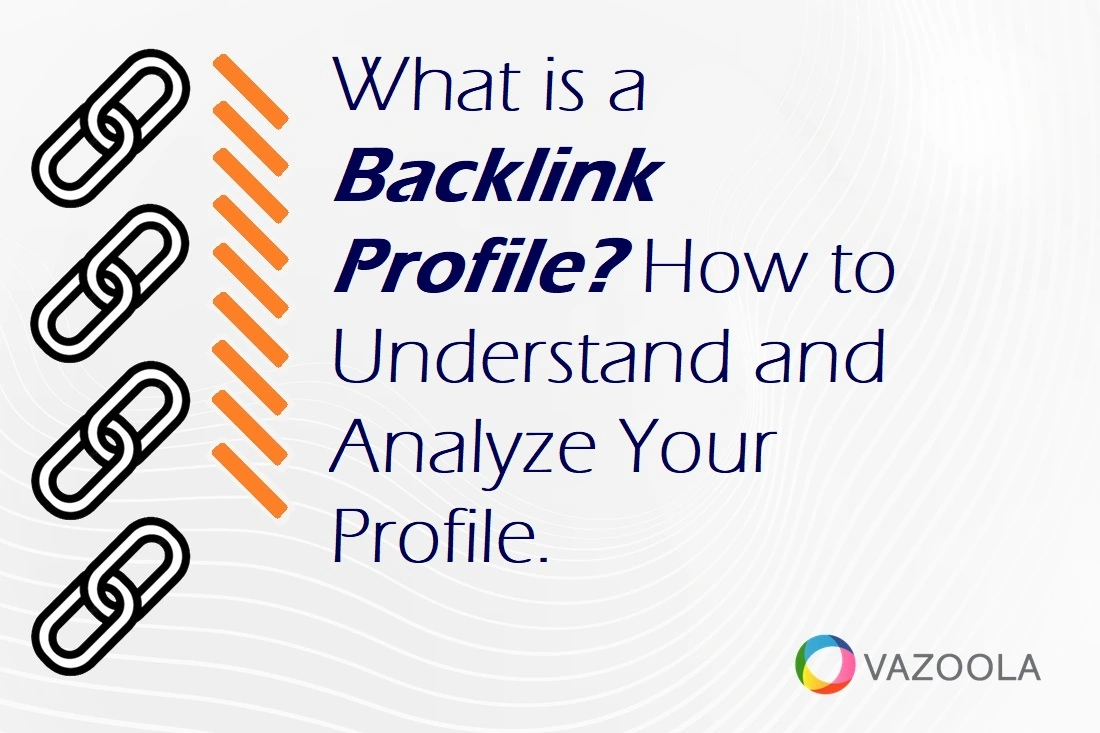
If you have a website with at least one backlink pointing to it, that means you have a backlink profile! Why should you care about this? Because Google and other search engines analyze your backlink profile when determining how to rank your website. Having a strong backlink profile helps search engines understand your site's relevance and authority, impacting how it is positioned in search results.
To improve your backlink profile, you’ll need to use link building strategies to systematically get new backlinks pointing to your site. Why would you want to do this? We’ve already detailed all the benefits of building links in this post, so check it out! In short, it gives you control over how well your site ranks in the search engines.
The number of pages that Google crawls per day can vary significantly. In fact, there are some pages—along with entire websites—that Google doesn’t choose to crawl. However, if you use high-quality backlinks, your odds of being picked up and crawled quickly by Google will greatly increase.
We routinely help clients analyze and interpret their backlink profiles and use the data to inform their Link building strategies. Just in case you’re still confused, a backlink is simply a hyperlink from another website that points to yours.
For instance, B2B ratings & reviews website Clutch.co backlinks to Vazoola, and lists us as a high quality link building services agency.
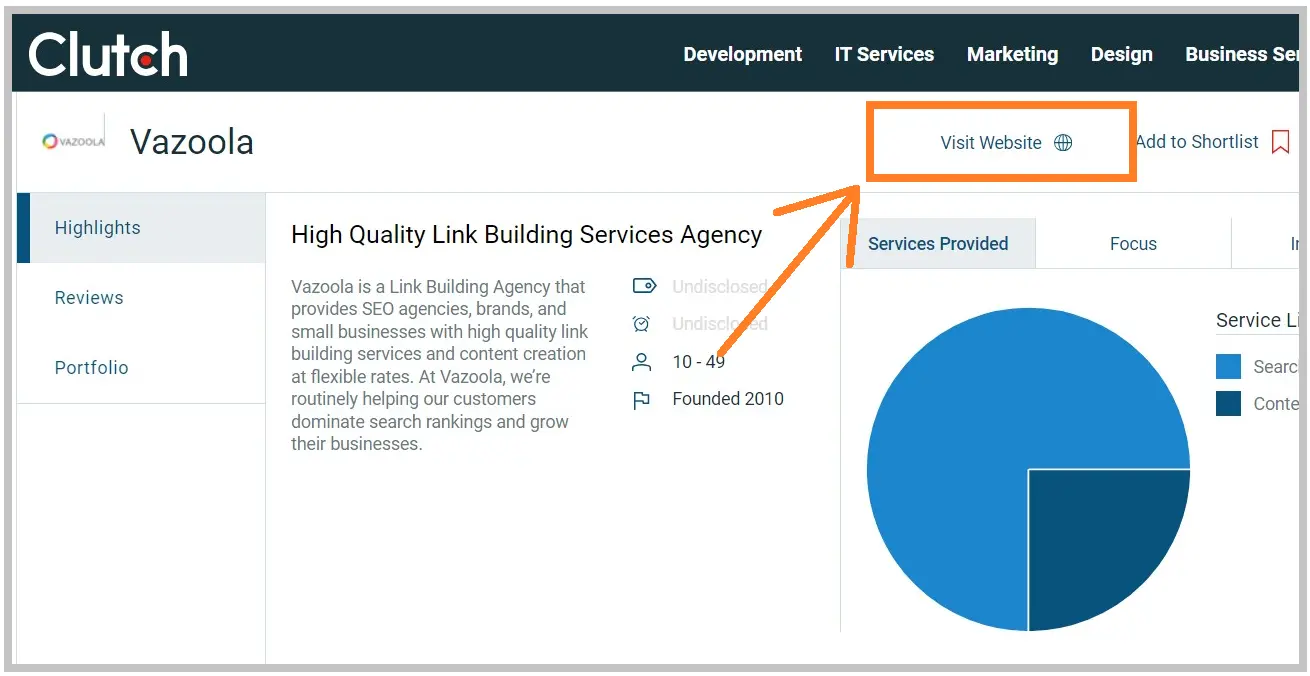
Click on the Visit Website blue text, and you are magically transported back to Vazoola's homepage. Well, maybe it isn’t "technically" magic, but it’s still pretty cool!
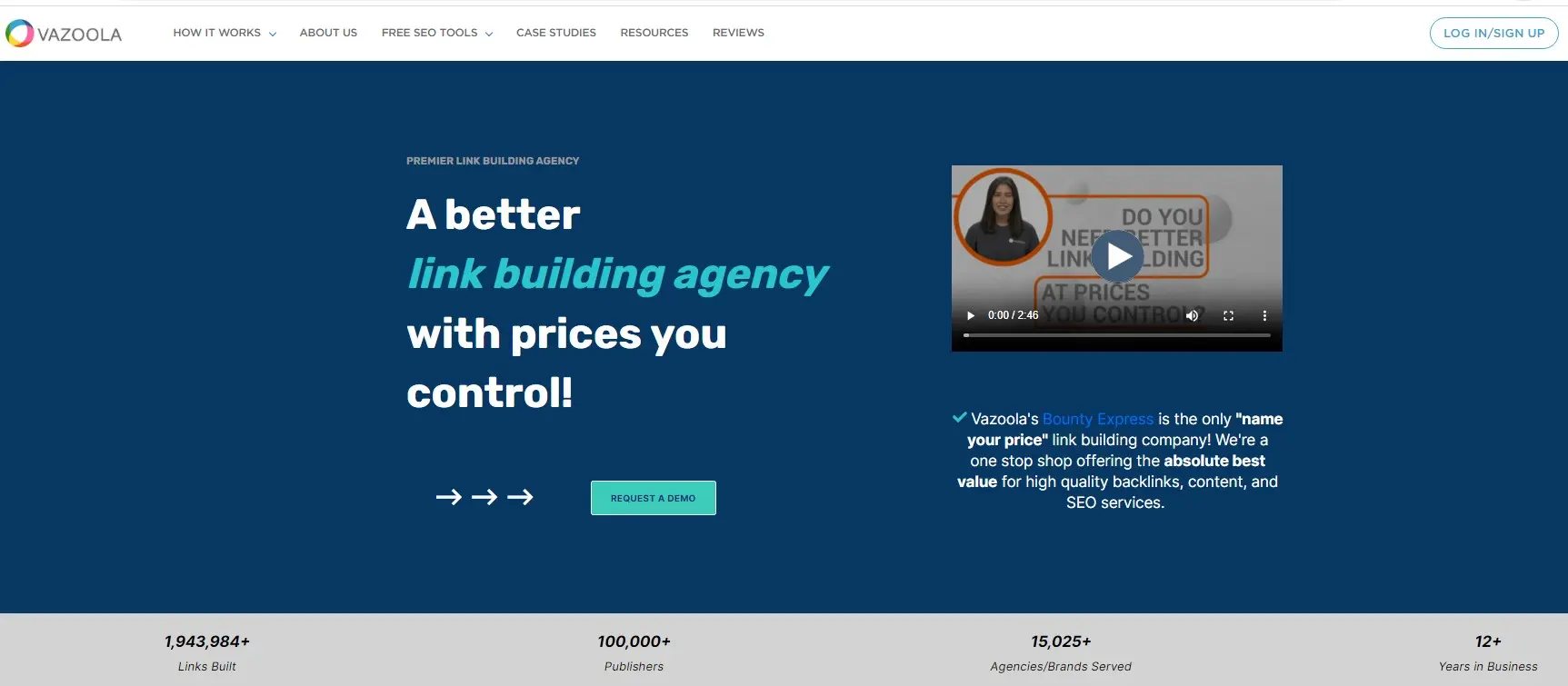
Key Takeaways:
-
A backlink profile, sometimes called a link profile for short, is the total number and quality of backlinks pointing back to all the pages of your website. Search engines crawl and analyze your link profile, including the links pointing back, as a way to determine your site's authoritativeness and position in the search engine results pages.
-
Understanding your backlink profile is key because it helps you develop a link building strategy, set a budget, determine requirements to rank, and find backlink targets.
-
Find your backlink profile by using Google search console or an SEO tool like ahrefs, Moz, or SEM Rush.
-
Anchor text use, backlink quality, link diversification, Link equity ratio and link velocity are key factors that influence backlink quality.
-
The three main ways to grow your backlink profile are earning, building, or buying links. Make sure you’re not losing links by monitoring backlinks and repairing lost and broken links.
-
Toxic backlinks can be harmful to your backlink profile. Take the time to identify and assess potential toxic backlinks in your profile.
Table of Contents:
What is a Backlink Profile?
A backlink profile sometimes called a link profile for short, is the total number and quality of backlinks pointing back to all the pages of your website. Search engines crawl and analyze your link profile, including the links pointing back, as a way to determine your site's authoritativeness and position in the search engine results pages.
Your link profile includes an evaluation of link characteristics like the number of backlinks, along with the quality of the links pointing back since both are essential. Additionally, this profile details other link characteristics, such as the types of links pointing back, as well as their anchor text, domain quality, and relevance.
Essentially, you can think of your backlink profile as a collection of votes of confidence. The more backlinks you acquire, the more votes of confidence you have!

While people often talk about a link profile in connection with the whole website, it can also apply to a specific web page.
Next we'll break down the difference and look at the terms that will help you understand your link profile.
Terms For Understanding Backlink Profiles
To truly understand what your backlink profile is and how it can help you, you’ll need to first grasp each of the following terms:
-
Domain Authority - This is a measure of your website's authoritativeness signaled by your backlink profile. There are many different versions of this metric available from different SEO tools. For example, Ahrefs has Domain Rating (DR), MOZ has Domain Authority (DA), and SEM Rush has Authority Score. These are all good comparative metrics that tell you how likely your site is to rank against another.
-
Referring domains – When another website has a backlink to your website, they’re known as a referring domain. One referring domain can send multiple links to your site, but it still only counts as one referring domain.

-
Backlinks – When one website provides an anchor text link to another website. A website can send more than one backlink to your site, but only the first one holds the majority of the value.
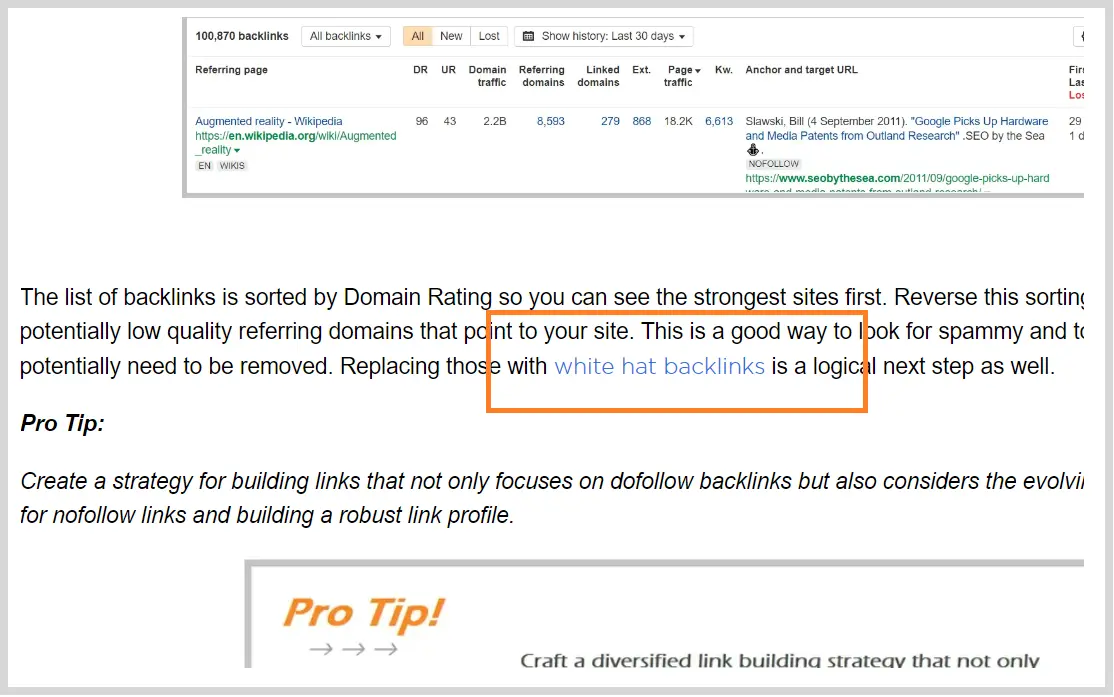
-
No follow/Do follow – A ‘no follow’ link does not affect search engine rankings. A ‘do follow’ link, however, does affect search engine rankings because it passes link equity. Therefore, you want to acquire as many ‘do follow’ linkbacks as possible.

-
Anchors – Anchor text is the phrase used on top of the hyperlink to another website. If done correctly, anchor text links are highly valuable, as the people who click on them know exactly what to expect.
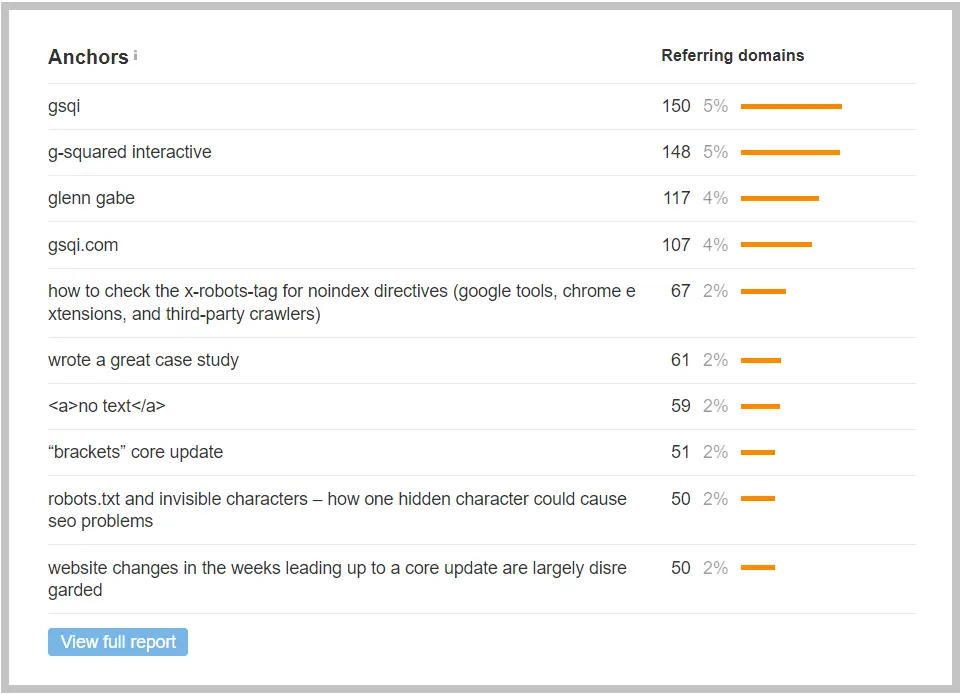
-
Linking URL – URL means ‘uniform resource locator.’ This is referring to the specific page that is sending you the backlink.
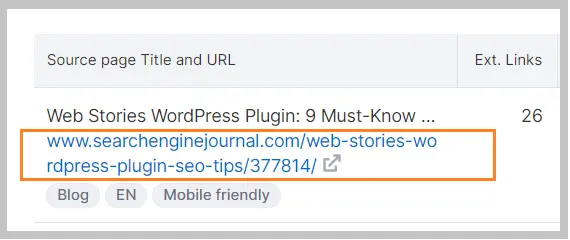
-
Internal Links – Linking to another relevant page on the same website is known as an internal link. While beneficial for SEO as an on-page signal, internal links shouldn't be mistaken for backlinks, as they originate from the same site. An inbound link becomes a backlink only when it comes from another website.
You have to give outbound links to get inbound links, correct? Let’s slow down for a second and really analyze how this works and whether you want to link to other websites freely.
The Importance of Understanding Your Backlink Profile
It’s vital to create a strong backlink profile. After all, this is one of the best ways to ensure that your website is successful. To truly get the most out of it, you must also understand which backlinks have more power than others. For instance, if all of yours come from newer sites without authority, it will be less valuable than if you acquire only a few of them from well-known, highly relevant sites.
Learning to fully understand your link profile will help you accomplish several things:
Improve your strategy
How well does your backlink profile meet your goals? Is it significantly raising your search engine ranking, or has it barely made a dent? These are the questions you need to ask yourself when you review your backlink profile. Whatever your answers are should inform how you move forward, along with how much more work you need to do.
Budget better
Understanding your backlink profile will help you to determine the resources or specific budget you want to allocate to backlink building. Your backlink profile will show you the kinds of links you already have pointing to your site. The link profiles of your competitors will then give you insight into what links you need to acquire in order to outrank them and what it will take to do it.
Determine requirements to rank
Analyzing your own and your competitor's backlink profile will give you insights into what it will take to rank on the first page. You first need to analyze your profile to understand your site's overall level of authority, and then narrow down your analysis to the page level.
Compare your own sites total referring domains, domain authority, highest premium links, and lowest quality links to your direct competitors.
When we make recommendations to clients about what keywords they should focus on in their strategies, we find them keywords that match the authoritativeness of their link profiles to ensure that they have the best possible chance of ranking.
Here's a quick example. We start by looking at our clients' DR from Ahrefs, which is a measure of a websites authoritativeness through the lens of its backlink profile. Then we compare Ahrefs Keyword Difficulty and DR for a quick analysis of likelihood to rank. Your domain authority should be as least as high the difficulty score assigned to the keyword, otherwise you are not likely to be able to compete for the top positions in search engine results pages, even if you have the best content.
Helps find backlink targets
Reviewing your backlink profile makes it easier to discover which sites have given you a backlink. It also helps you discover which highly rated sites in your niche have not linked back to you. Make a list of your most desirable websites—be sure to remain in your niche—and start reaching out to them. Again, your competitors' link profiles will be of value to you here. Close the link gap between you and your top competitors by identifying which sites like to them that don't yet link to you.
You can also see what types of content on your competitors' sites get the most backlinks and then create similar content to attract more of them to your own site.
How to Find and Check Your Backlink Profile
Finding your backlink profile is easier than you think! There are a host of free and paid tools available for viewing and analyzing your backlink profile.
Choose a Backlink Checker
It’s quite easy to find. In fact, you just have to know where to look!
-
Vazoola: Vazoola offers a powerful platform that connects agencies with publishers, simplifying the process of building quality backlinks.
-
Ahrefs: Ahrefs is renowned for its comprehensive backlink analysis tools that provide insights into your website's performance, including an extensive breakdown of your link profile.
-
SEM Rush: SEM Rush provides an all-in-one marketing toolkit, including robust backlink tracking features that help you understand your site's ranking and how to improve it.
-
Google Search Console: Google Search Console: is a free tool from Google that helps you monitor, maintain, and troubleshoot your site's presence in Google Search results, including viewing who links to you.
-
Majestic: Majestic specializes in backlink analysis and offers unique tools such as the Majestic Trust Flow to assess the quality and trustworthiness of sites that link to you.
-
Moz Link Explorer: Moz Link Explorer is part of Moz's broader SEO toolset, giving you a snapshot of your site's link profile, anchor text data, and the strength of individual links that point back to your site.
Pro Tip: Check your website’s backlink profile with at least two different tools to ensure you get the full picture.

Analyze your backlink profile
The only way to know what’s really going on with your website is to take a look at your backlink profile. Once you've accessed your backlink profile using your preferred tool, collect as many of the data points listed below as you can.
-
Domain authority
-
Number of backlinks and referring domains
-
Dofollow vs. no follow links
-
Link velocity
-
Link equity ratio
Knowing these metrics will help you compare your backlink profile to your competitors as well as serve as benchmark data so you can evaluate your progress over time. This is only a brief look at your backlink profile, but we show you how to dive deeper in our other article on backlink audits.
Here is an example of a snippet from a typical backlink profile available from various tools. You can see some basic metrics such as referring URL (page), domain authority, anchor text, date the link was acquired and more.
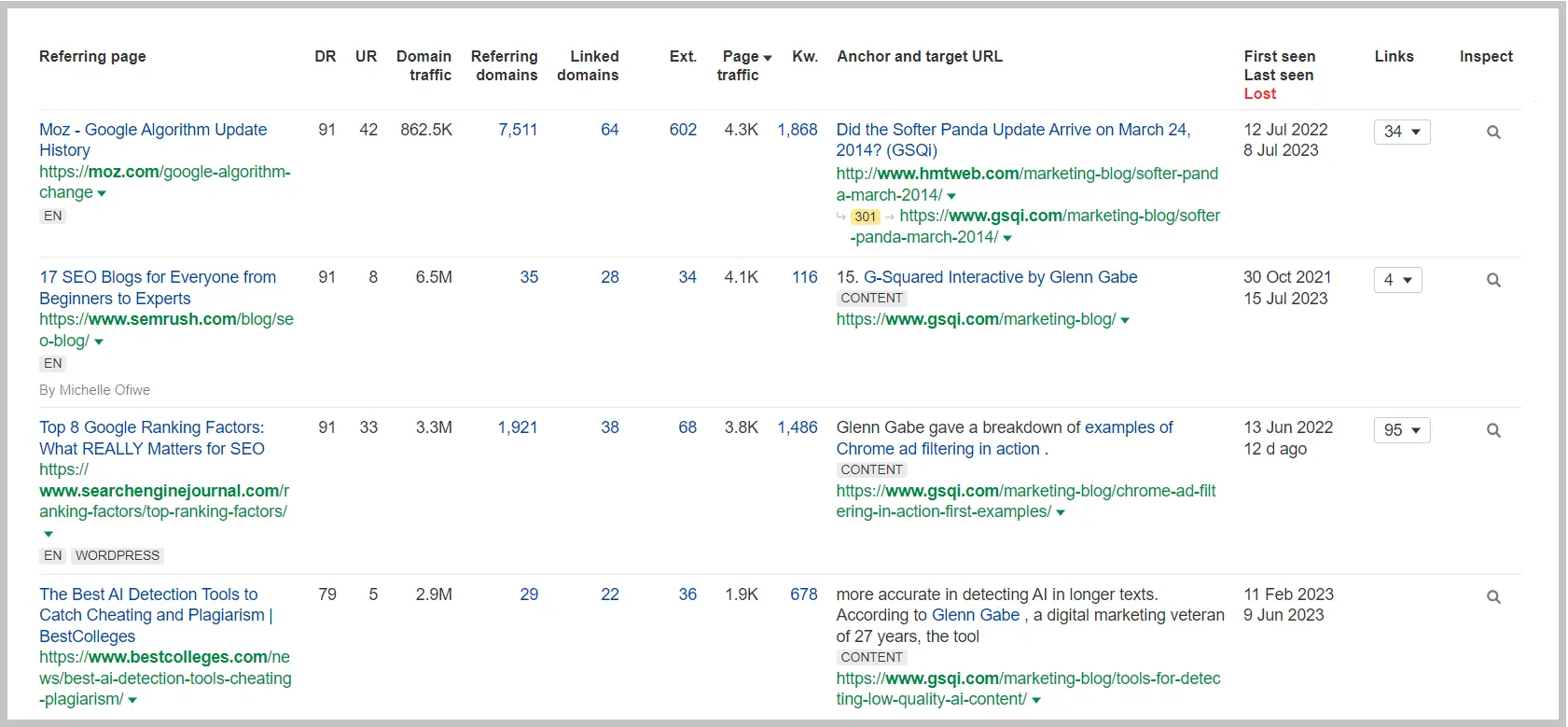
Each tool with have its own data to display, but there will always be some overlap. Here's another example.
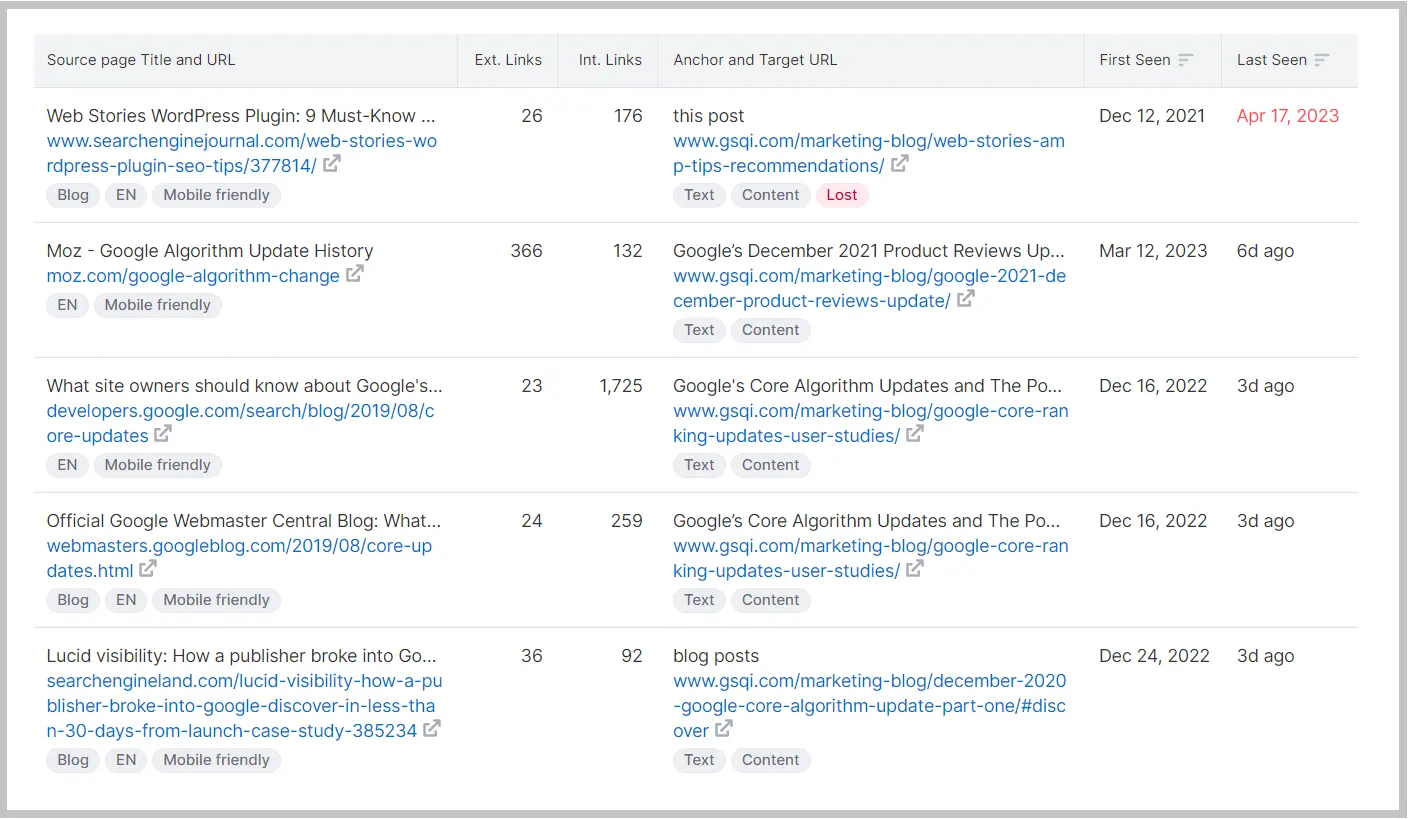
Utilize Google Search Console for Backlink Profile Analysis
In the context of SEO metrics, utilizing Google Search Console to examine and analyze your backlink profile reveals a lot. Mainly – that the total number of referring domains is more valuable than merely counting links since numerous backlinks might originate from a single domain.
Here is a word from Ahrefs on how to use Google's Search Console to Elevate Your SEO:
Factors that Influence Backlink Profile Quality
Even if you’ve got 500,000 links back to your site, your job is far from done. It’s vital to ensure the links back to your site are quality, too. The following aspects greatly affect your link portfolio’s quality, so remember to check them.
A high-quality backlink profile should have:
-
Good Page Authority (PA) or Domain Authority (DA): Every time a site links to another, it sends link equity to the linked page. Metrics developed by Moz that predict how well a domain or webpage will rank on the search engine results pages (SERP).
-
Relevance: Backlinking should come from pages that cover the same or similar topics as your site, even if the entire domain isn't directly related to your niche.
-
Traffic: Links that send more traffic, particularly organic traffic, to your site lead to more sales, leads, and additional linkbacks to your site.
-
Uniqueness: Links that are difficult to obtain, making them unique and valuable, like those from a niche-specific chamber of commerce directory.
-
Dofollow Tags: Targeting 'do follow' linkbacks, as they pass full equity to other pages, rather than 'no follow,' which do not.
-
Proper Anchor Usage: The text used to link to your site should be relevant to the topic and carefully chosen to avoid triggering search engine penalties.
It should avoid
-
Irrelevant Backlinks: Links that have no connection to the content or subject of your site. Also avoid most of your links coming from subpar irrelevant sites.
-
Overuse of Easy-to-Get Links: If a link is too easy to obtain, then it lacks uniqueness and could be common among competitors.
-
Too Many Nofollow Links: Though useful, no follow links do not pass link equity, so an overreliance can reduce impact.
-
Exact-Match Anchor Texts: Overusing exact-match anchor texts can risk triggering penalties from search engines like the Penguin algorithm.
-
Ignoring Traffic and User Experience: Solely focusing on SEO without considering the actual user click-through to useful pages can be detrimental. By paying attention to these factors, you can ensure that your backlink profile is strong and contributes positively to your website's rankings.
-
Too many Branded URLs: Branded URLs can direct traffic to your site through your brand, but their ability to attract new traffic is limited. They're useful for solidifying your brand and diversifying your profile, but have restrictions in reaching new audiences.
About anchor text ratio, diversification
Did you know that there are several different types of backlink anchor texts? Search engines use keyword anchors as a signal which means you want to understand your own use of anchor texts and make a plan to take control of it.
Here's a list of the common types of anchor texts below:
-
Naked URLs – A naked URL is a website link with no anchor text (example of a naked URL: https://www.vazoola.com/)
-
Branded – Branded anchor text that links to the main website (example: Vazoola)
-
Long Tail – Keyword anchor text of at least four words (example: check your backlink profile)
-
Exact Match – Anchor text that exactly matches your keyword (example: link building agency)
-
Partial Match – When the keyword anchor text matches part of your keyword (example: link agency)
-
Empty – There is no anchor text. This usually means an image is linked. (example: the image below)
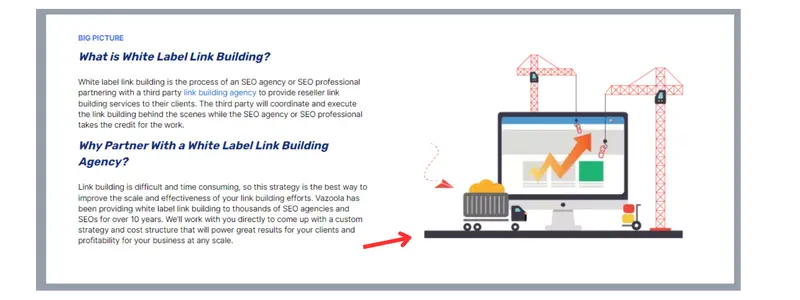
-
Topical – Anchor text that doesn’t match your keyword but is in the same general category. (example: boost traffic)
-
Miscellaneous – Intended for the user. Does not have relevance to keywords. (example: Click here!)
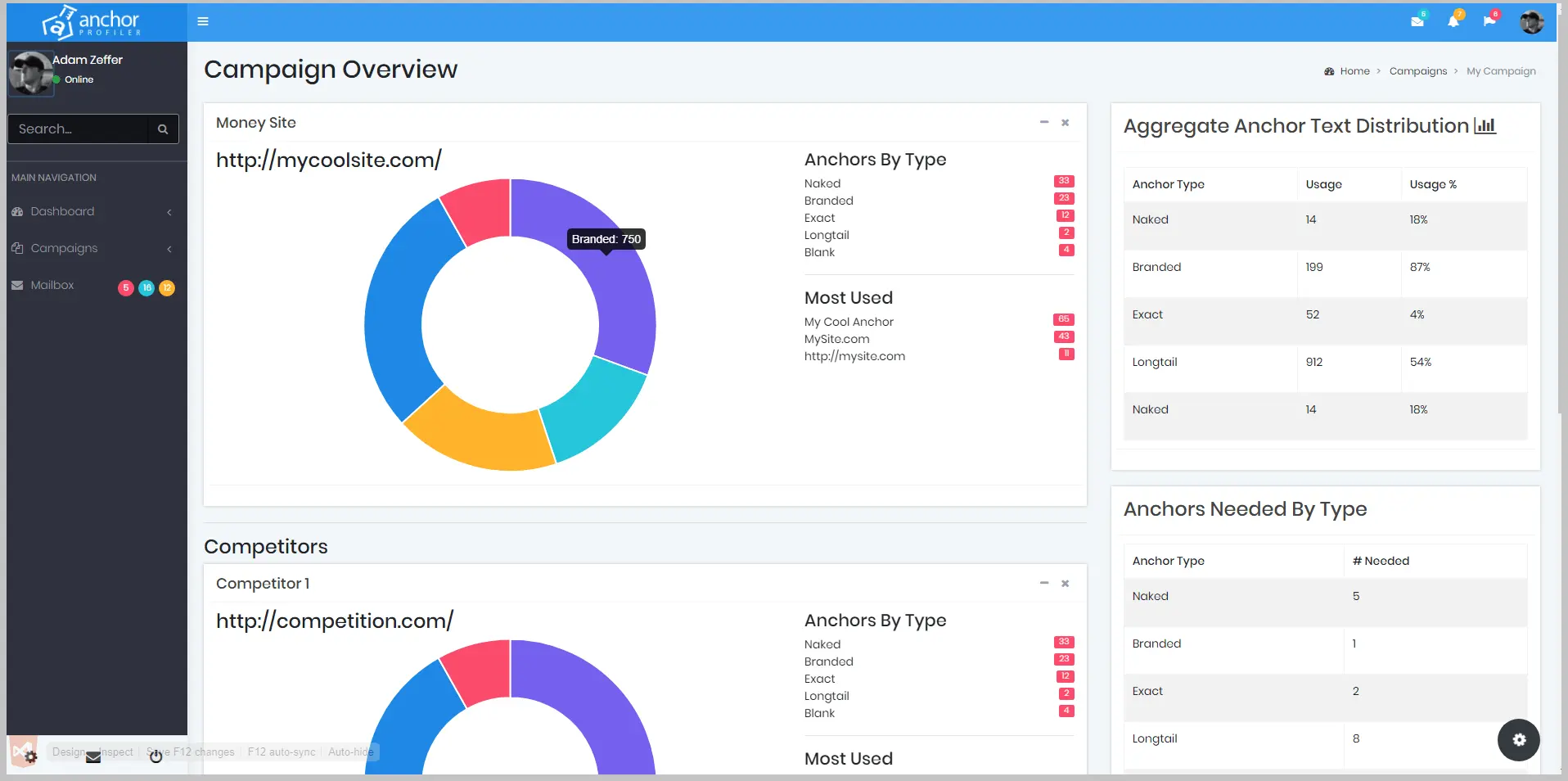
To construct an effective backlink profile, diverse anchor texts are essential. Examining the assortment of your anchor texts may reveal keywords or phrases that have been excessively utilized in your backlink anchor text.
So, which anchor text will be best for you to use? It depends on what you’re trying to accomplish. Specialists here at Vazoola routinely use a tool called AnchorProfiler that crawls and makes an assessment of a websites anchor text usage as compared to its highest ranking competitors.
Consider the quality of links in backlinks profile
Before you begin a link building campaign to strengthen your backlink profile, let’s take a beat to consider the quality of each backlink in your profile. We've spelled out in detail what a high quality backlink is in another post on our site. Here's a quick look at the important things to look at when evaluating site quality:
-
Domain authority
-
Traffic
-
Referring domains
-
Anchor text relevance
-
Healthy anchor text ratio
-
Linking web page’s content relevancy and quality
-
Linking domain relevance and quality
-
The domains security status (https)
-
IP address
-
Link location
-
Natural looking placement
All the above and more go into determining whether you’ve got quality backlinks or not. To help you figure it out, use a link explorer such as Ahrefs or SEM Rush. Doing so will give you important details on the domains your backlinks are coming from.
Also, the quality of the links in your link profile is more important than the quantity. When adding new ones to your profile be sure you keep this in mind. We've seen time and time again at Vazoola that its possible to outrank pages and sites that have more total backlinks than our client sites, by using securing the right types of links on high quality sites.
Diversification of links in your profile
There are several different backlinks you can acquire, but some will help you more than others. The main backlink types are:
-
Dofollow - These are desirable because they pass link equity to your site
-
Nofollow - Search engines do not crawl these and therefore they do not pass equity to your site
-
In Content - Thee are placed naturally into content on the web
-
Guest Posts - These are the types point back to your site and are placed within an article that you write and post to another site as a guest contributor
-
Citation - These are found within your companies business profile, commonly listed in directories
-
Editorial - These are placed into new or PR pieces
-
Bio - These point to your site from author bio's you have placed on other websites
-
Comments - These are placed within the comments section of blog content or other web pages.
-
Forum - These are placed in forum posts
A backlink profile should have the right balance of different types of links. We recommend referring to top ranking competitors link profiles to see what balance Google favors, and then either build or attract the types that your profile is lacking.
Remember this for your SEO strategy too. When you are building backlinks, the links that point back from the same website start losing their value after the first one. After a while, they start losing their value altogether.
Location of link placement on web page
Does it really matter where your link is placed on a web page? Of course, it does! A good example of this can be found with how Google ranks multiple instances of the same link.
You see, whichever anchor text is used the very first time holds more weight with Google. Therefore, try to use your optimal keyword phrase the first time the link appears on each page.
Now, let’s take a closer look at some key website locations:
Body
Per John Mueller from Google, the position a link has within the body text matters. So, for instance, if you have three backlinks you need to sprinkle into the body text, pick the most important one and place it first.
Comments
Comments are tricky, especially because of how often they’re used to post spam. Although leaving a lot of comments with your link may get Google’s attention, these are considered low quality links. They are NOT going to help you.
The only possible exception to this rule is if your links are woven into your comment in a natural way. Still, Google tends to shy away from boosting websites that have acquired the majority of its linkbacks through comments on other websites.
Profile
Two types of profile links include business profiles and author bios. Profiles are commonly listed in directories and include a business's name, address and phone number (NAP) along with a backlink typically leading to the home page or key service page.
Backlinks are often included in the author bio of a writer from a website who has placed a guest post on another website. The more guest posts you write for other sites, the more high authority links you can accumulate.
Image
If you use image links effectively, it can be a boon for your website! First off, be sure to use original images such as an infographic. This isn’t the time to use stock photography. Secondly, be aware that Google counts these linked images, but some of the other search engines do not. Finally, if there are websites that are using your images without giving you credit, it’s time to contact them. Getting them to add your credit in the form of a backlink is definitely worth it.
Footer
According to Moz, putting a link in the footer of your website isn’t going to help you achieve a higher search engine ranking. If anything, it will devalue your website. Therefore, if you have a good reason to put link in your footer, make sure you format them as nofollow links.
Sidebar
Putting links in the sidebar of your website won’t really help you, but it won’t necessarily hurt you, either. In some instances, it is held against you, however. Instead of going down this road, though, it’s better to determine where you should actually put your links.
For example, you should put links where they’ll provide the most use to your visitors. Is that really in your sidebar? The odds are high that it’s not.
Relationship between backlink profile and Domain Authority
There is a direct relationship between the type of backlinks you acquire and your site’s domain authority (DA). If you develop quality inbound links, it will boost your DA. On the other hand, if you rely on spammy links, it will hurt your DA.
Location of referring domains
Getting a backlink from another country may enhance your site's visibility, but it won't have the same effect as a backlink from a local referring domain. This is particularly true for locally based businesses like an independent bookstore.
Google scrutinizes everything about the referring domain to assess its quality. When they recognize that your website and the referring domain are located in the same city, it knows to rank you higher there.
The same logic applies to referring domains from your own country, although the impact might not be as significant. Essentially, you should strive for as many quality backlinks as possible. But if you must choose between two sites, you should almost always select the referring domain that's from the same city as you.
Outbound vs. inbound links
You have to give outbound links to get inbound ones, right? Let’s slow down for a second and really analyze how this works and whether you want to link to other websites freely.
Outbound links are an important signal to Google that helps them understand your site's niche and industry. They also are a way to help your audience navigate to other relevant parts of the web and find related useful information.
Another thing to know about link count is that if your website has 10,000 outbound links but only 1,000 inbound ones, you’ll have less link equity to pass onto other sites.
What you want to shoot for is the reverse scenario: 1,000 outbound links and 10,000 inbound ones. As long as you use quality inbound links, this will signal Google that your site has been recognized as an expert in your field.
To put it in terms of a healthy ratio, always try to get your ratio to be higher than 1. In other words, if you can get 1.5 inbound links for every outbound link, you’re on the right track! If you don’t, you’ll have some work to do to boost SEO performance.
How to Grow a Backlink Profile
Growing your backlink profile can be done in a number of different ways. The three ways to get new links that point back to you fall into three categories:
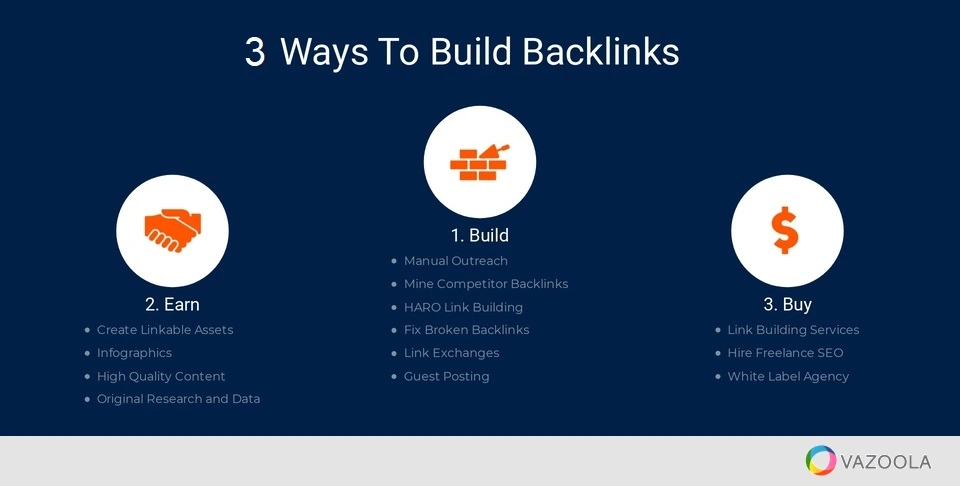
Earn Links
One of the best ways to earn these are through posting high quality content that includes linkable assets. This means providing an in-depth, long-form guide, a data-driven study, or an infographic or other visual. Each of these things has the potential to impress others, which will result in a backlink.
Build Links
You can build your own! Be sure your site’s profile contains a backlink, for starters. This is an often overlooked but viable resource for backlinking. You could also place them in comments, but this will probably end up hurting your site. Building networks is another fantastic way to grow your profile and build relationships with other website owners.
Buy Links
Most people think there’s something wrong with buying backlinks. The truth, though, is that buying backlinks is a very common way of acquiring them. Basically, what Google cares about is whether the sites that link to you are high quality and relevant. As long as your backlinks are placed naturally on high quality, trusted websites that adhere to Google's guidelines, it's perfectly acceptable to buy them.
You do have to be careful, however. Don’t purchase any that are no follow or sponsored because they won't benefit you. What you want is follow hyperlinks from well-known, high-quality, and trusted websites.
Check for lost hyperlinks
Once you’ve received a link, that’s it, right? Wrong! You must always keep an eye on all your backlinks to ensure they stay up. Fortunately, you can do this by using backlink monitoring software. Or alternatively, you could check Ahrefs on a regular basis.
Fix broken hyperlinks
Broken hyperlinks are also a big problem. However, you can use broken link building to your advantage. Let’s say you find a listicle containing 30 websites, but one of those hyperlinks is broken. What should you do?
For starters, tell the owner of the content how much you enjoyed their article. Then, mention that one of the links to an item on their list is no longer working. This will give you the opportunity to suggest a replacement item (from your website, of course!). The writer is likely to respond because you gave them a compliment and made it easy for them to fix their list!
Pro Tip: When doing any kind of link building outreach always make sure you communicate the benefit the other party will receive, rather than trying to get something from them.

Backlink Profile Rate of Growth
It can be difficult to figure out how many backlinks you should try to acquire per month for your backlink profile. Some sources say that the number truly doesn’t matter, and that it’s all about quality. However, one thing that everyone seems to agree on is that brand new sites shouldn’t try to capture hundreds of them in their backlink profile right away.
Essentially, you want to seek out premium ones from other sites over time at a rate that is higher than your competitors, but not unnaturally high. Going from no backlinks to 500 of them in between two times Google has checked your site will seem odd. It’s also a pretty safe bet that most of those will not be high quality, which means that they’ll hurt you instead of helping.
Going too fast will definitely look unnatural. Going too slow, though, may not be competitive enough. Always be looking for high quality backlink opportunities from other sites!
Watch Out For Toxic Backlinks
Our final topic for today is a big one – toxic links. In the SEO World, they are also known as link spam and consist of irrelevant or low-quality linkage that point back to your site.
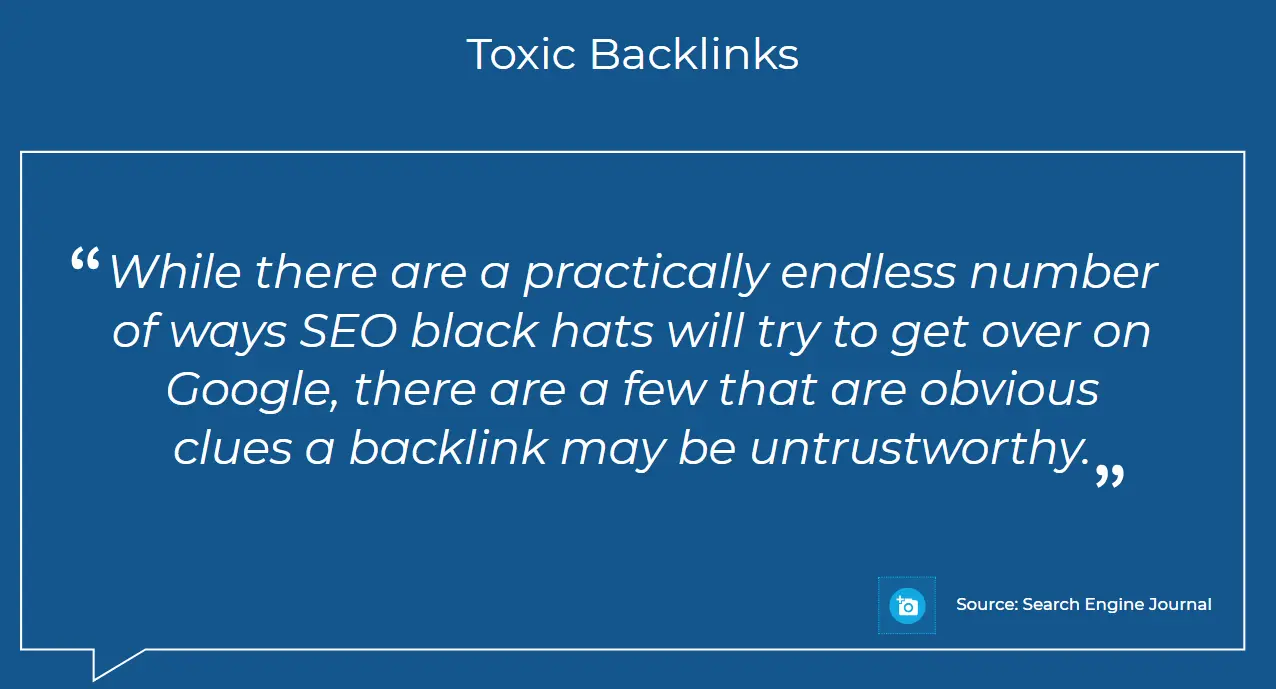
The danger of these inbound links is that your Google ranking can take a pounding, no matter what. If a website has an abundance of low-quality and irrelevant links, commonly referred to as link spam, it signals to the search engines about an attempt to manipulate its algorithms.
These inbound hyperlinks can destroy your Google ranking, regardless of your other SEO tools.
Toxic backlinks hurt your website due to them coming from:
-
Spammy, low quality sites.
-
A paid link mill.
-
A foreign blog’s comments.
-
Hidden text on a website.
-
low quality PBNs.
Due to Google Penguin’s Algo update, these toxic backlinks became even worse. It nullifies any spammy hyperlinks and low-quality referring sites. This means that all the work you put into acquiring these specific backlinks becomes absolutely worthless.
If you want to keep your backlink profile healthy, you will need to do a backlink audit. Run a backlink analysis using your favorite SEO tool (we recommend any of the backlink checkers from above) and compile a list of toxic hyperlinks.
These tools will often give you a spam score and Trust Flow (TF) you can use as a starting point. Some will even display a website niche for an easier overview. Nonetheless, you should review the backlink report manually and use your own judgment.
Once you find toxic hyperlinks, your SEO strategy should involve using a tool to help get rid of them, which we will touch on next.
Disavow Tool
There is a tool that can allow you to disavow all toxic backlinks. We recommend it only be used if you receive a manual action from Google, though, which you absolutely don’t want to get.
A manual action means that a human operator reviewed your website and found it to be non-compliant with Google’s spam policies. If you’re unlucky enough to get a manual action, you should take immediate action by disavowing toxic backlinks. If you fail to do this, your website might be removed altogether from Google’s search engine rankings.
You can use Ahrefs’ Backlink Checker for this. According to Ahref, “If you notice some suspicious backlink activity, you can add these spam links to a disavow file directly from the Backlink Checker. Importing this file into Google’s Disavow Tool takes only a few clicks.”
Final Thoughts
If you have to build backlinks for an website, the task may seem challenging, but with the understanding of how it can be achieved, and a clear vision of an ideal backlink profile, you're now prepared to face the challenge. Keep plugging away at it; before long, you'll have a strong and natural backlink profile.
If you're looking to optimize your link portfolio, enhance your website's ranking, and ensure that Google picks up your pages, your link building efforts need to be strategic and high-quality. Vazoola can assist you with backlink profile analysis, white label backlinks, and implementing proven link building strategies.
Ready to take your link building efforts to the next level? Learn how Vazoola can support your growth through customized SEO strategies. Find more by booking our free demo session.

